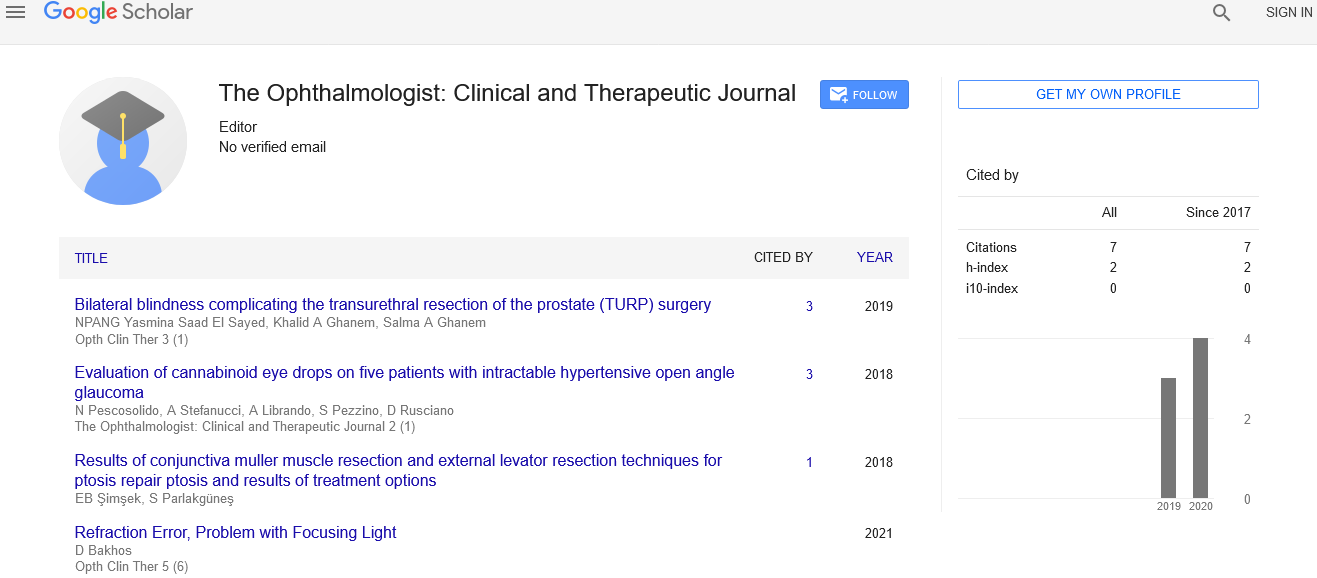Human cornea
Received: 10-Jan-2022, Manuscript No. PULOCTJ-22-4254; Editor assigned: 12-Jan-2022, Pre QC No. PULOCTJ-22-4254(PQ); Accepted Date: Jan 12, 2022; Reviewed: 18-Jan-2022 QC No. PULOCTJ-22-4254; Revised: 21-Jan-2022, Manuscript No. PULOCTJ-22-4254(R); Published: 11-Feb-2022, DOI: DOI:10.37532/puloctj.22.6.1.1
Citation: Wang N. Human cornea. Opth Clin Ther. 2022;6(1):1.
This open-access article is distributed under the terms of the Creative Commons Attribution Non-Commercial License (CC BY-NC) (http://creativecommons.org/licenses/by-nc/4.0/), which permits reuse, distribution and reproduction of the article, provided that the original work is properly cited and the reuse is restricted to noncommercial purposes. For commercial reuse, contact reprints@pulsus.com
Abstract
Single Cell (SC) examinations of key undeveloped, fetal and grown-up stages were performed to create a thorough single cell map book of all the corneal and adjoining conjunctival cell types from advancement to adulthood. Four human grown-up and seventeen early stage and fetal corneas from 10 to 21 Post Origination Week (PCW) examples were separated to single cells and exposed to scRNA-and additionally ATAC-Seq utilizing the 10x Genomics stage. These were implanted utilizing Uniform Manifold Approximation and Projection (UMAP) and bunched utilizing Seurat chart based grouping. Bunch recognizable proof was performed in light of marker quality articulation, bioinformatics information mining and Immunofluorescence (IF) investigation. RNA impedance, IF, state shaping effectiveness and clonal tests were performed on refined Limbal Epithelial Cells (LECs).
Key Words
Limbal epithelial cells, cornea, scRNA-Seq, immunofluorescence
Introduction
Cornea is the straightforward forward portion of the eye, which along with the focal point shines the light onto retina for visual handling. Corneal visual impairment is the second primary driver of visual impairment overall representing 23 million individuals, adding a colossal weight to medical care assets. Regularly the main treatment is careful transplantation of benefactor cornea, a restorative choice that has been by and by for over a century. In Europe, more than 40,000 visually impaired individuals are hanging tight for corneal transfer consistently. This overall deficiency of corneas results in around 10 million untreated patients worldwide and 1.5 million new instances of visual impairment yearly. The cornea is contained five layers: the peripheral epithelium, Bowman’s layer, the stroma, the Descemet’s film and the endothelium. The separated epithelium covers the peripheral surface of the cornea and is partitioned from stroma by Bowman’s layer, a smooth, acellular layer comprised of collagen fibrils and proteoglycans, which assists the cornea with keeping up with its shape. There is high corneal epithelial cell turnover because of flickering as well as physical and synthetic ecological affronts. The recharging of corneal epithelium is supported by the Limbal Undeveloped Cells (LSCs), which are situated at the Palisades of Vogt at the limbal district that denotes the progress zone between clear cornea and conjunctiva. To more readily comprehend the intricacy of human visual surface, we performed single cell investigations of human cornea and nearby conjunctiva during human turn of events and in adulthood, in consistent state and sickness conditions. A comparative methodology was applied to the visual foremost section in mouse, prompting distinguishing proof of an original marker for stem and early travel intensifying cells, TXNIP. While this work was under survey, two examinations announced the single cell transcriptomic investigation of human limbal basal epithelium and murine corneal non-myelinating Schwann cells. Our review supplements and grows this distributed information by giving a far reaching single cell chart book of the entire creating and grown-up human cornea and adjoining conjunctiva that characterizes their turn of events, limbal begetter cells and their collaborations with safe cells.
Result
scRNA-Seq examination of 21,343 cells from four grown-up human corneas and contiguous conjunctivas uncovered the presence of 21 cell groups, addressing the forebear and separated cells in all layers of cornea and conjunctiva as well as safe cells, melanocytes, fibroblasts, and blood/ lymphatic vessels. A little cell bunch with high articulation of Limbal Begetter Cell (LPC) markers was distinguished and shown by means of pseudotime investigation to bring about five other cell types addressing all the subtypes of separated limbal and corneal epithelial cells. A novel putative LPCs surface marker, GPHA2, communicated on the outer layer of 0.41% ± 0.21 of the refined LECs, was recognized, in light of prevalent articulation in the limbal tombs of grown-up and creating cornea and RNAi approval in refined LECs. Joining scRNA-and ATAC-Seq examinations, we distinguished various upstream controllers for LPCs and showed a nearby communication between the invulnerable cells and limbal begetter cells. RNA-Seq investigation demonstrated the deficiency of GPHA2 articulation and obtaining of proliferative limbal basal epithelial cell markers during ex vivo LEC development, autonomously of the way of life strategy utilized. Stretching out the single cell examinations to keratoconus, we had the option to uncover actuation of collagenase in the corneal stroma and a diminished pool of limbal suprabasal cells as two key changes fundamental the sickness aggregate. Single cell RNA-Seq of 89,897 cells acquired from early stage and fetal cornea demonstrated that during advancement, the conjunctival epithelium is quick to be indicated from the visual surface epithelium, trailed by the corneal epithelium and the foundation of LPCs, which originate before the development of limbal specialty by half a month.





